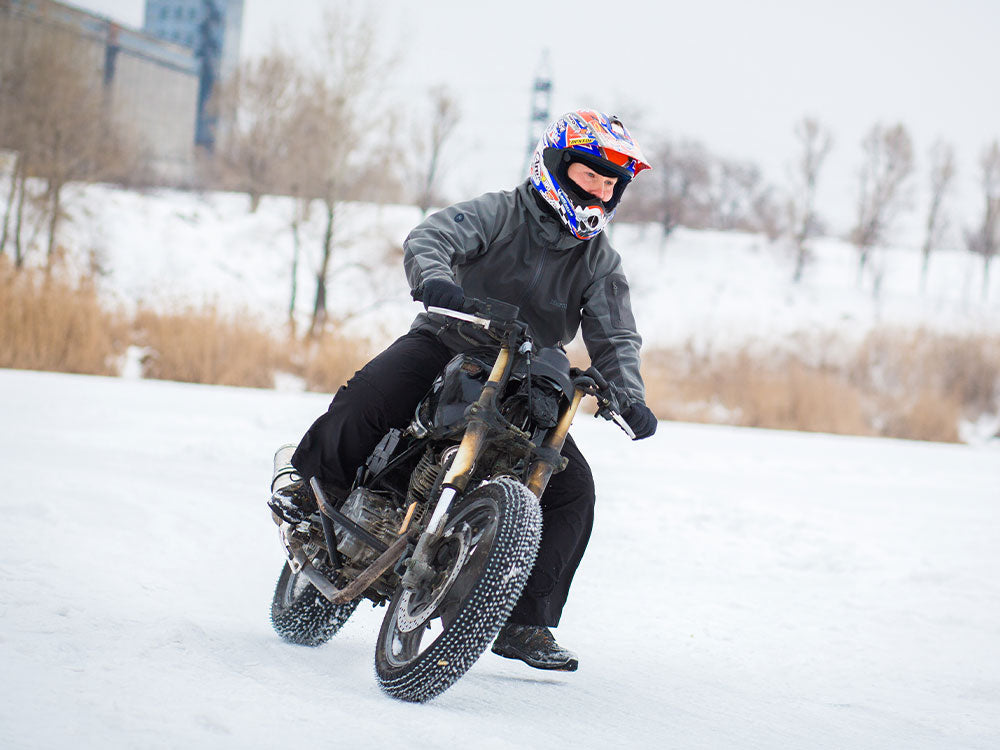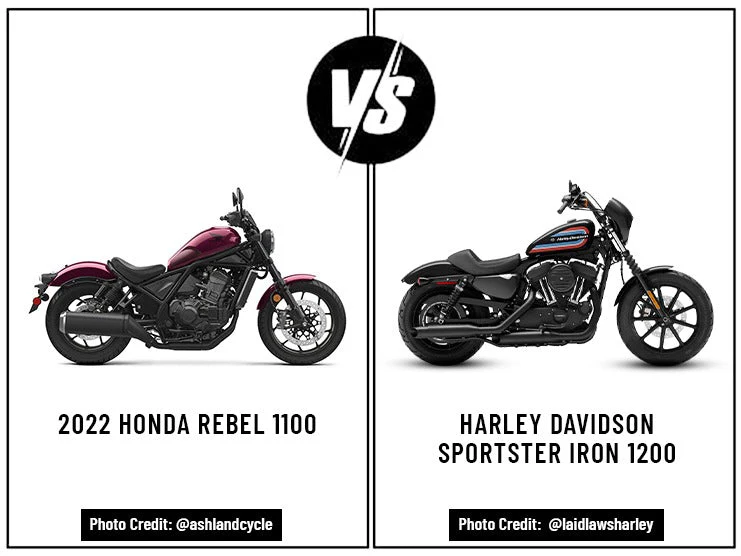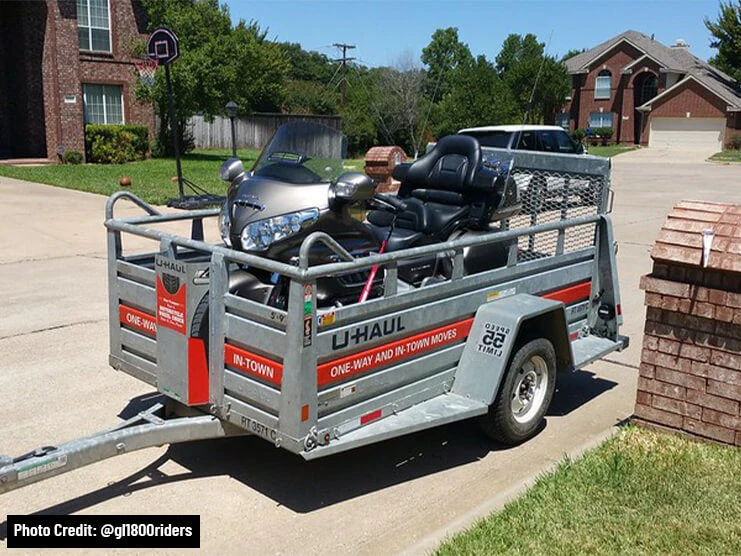Table of Content
Riding a motorcycle during winter is not the same as in summer. There are numerous factors to take into consideration if you want to ride comfortably during the winter months. Here are the checklist and tips for riding a motorcycle in Winter.
1. Essentials for Winter Motorcycle Riding

If you love to ride a motorcycle during winter, you will need the necessary gear to ensure a comfortable riding experience. You need to carry essential items in your motorcycle luggage and to increase the storage capacity you get yourself LEATHER, HARD, or UNIVERSAL SADDLEBAGS. Here is a checklist of everything you will need for winter motorcycle riding.
1.1. Winter Motorcycle Riding Suit
The most important thing for comfortable motorcycle riding during the winter is wearing suitable winter motorcycle clothing. These include the following:
Heated Base Layer
A heated base layer will help keep your body temperature high during winter riding. Choose a base layer that offers good insulation, such as a wool base layer or any moisture-wicking fabric. Determine how many layers you'll need and what materials they should be made of. Remember that even if you choose a full-riding suit, you may still need to wear one or two extra layers underneath.
Neck Warmer
To avoid freezing, it is best to wear neck warmers. Some riders believe that face shields and helmets eliminate the need for neck warmers. When it comes to extreme winter rides, wearing neck warmers will make your ride easier than relying on just face shields and helmets. Neck warmers provide extra warmth by rolling around and protecting motorcyclists’ necks and faces from direct wind.
A wool balaclava can be useful in cold weather conditions. Try to wear a long balaclava that runs from your neck to your chest.
Windbreaker
It helps to have a windbreaker with you in case you ride against freezing winds since windbreakers have insulating layers that prevent the loss of body heat and block the wind. If you have rain gear, carry it with you in case you need extra insulation or a storm suddenly appears. Rain gear may also provide extra warmth and insulating layers.
Leather Layer
The leather layer provides extra protection by blocking cold air from hitting your body. Wear a good quality leather jacket that provides the best insulation possible.
Winter Riding Jacket
When going out on a motorcycle ride during winter, have a winter riding jacket handy. Don’t settle for ordinary baggy clothes as they cannot reliably retain your body heat. Choose a winter motorcycle riding jacket with extra heat protection and always make sure the jacket is zipped fully. Another thing to keep in mind while choosing a riding jacket is that it must be flexible and allow freedom of movement.
Riding Gloves
Whenever you ride a motorcycle, your fingers are the most vulnerable to face colds, so it is essential to protect them to prevent numbness. Your fingers need to be kept warm to ensure better control over your motorcycle.
Gloves Options:
Leather Gloves: Leather gloves provide adequate insulation and protection for your fingers against cold winds.
Heated Gloves: Heated gloves have excellent insulation and constantly warm your hands, constantly keeping your fingers from freezing.
Lobster Gloves: Lobster gloves have all the fingers pressed together while the thumb is separate. The fingers retain warmth due to the body heat being shared between them.
Riding Boots
You must also have a pair of winter riding boots. Winter motorcycle riding boots must be large in size, provide reliable protection from snow, wind, and cold, and are made of waterproof materials.
Choose tall boots that can reach up to or overlap the bottom of your pants. Also, check that the riding boots are built to handle slippery surfaces. Wearing wool socks will also help slow down a drop in body temperature should your winter riding boots become full of snow or rain.
Helmet
A motorcycle helmet will protect your head from injury and cover your face from cold winds. Before buying a full-face helmet, check the headliner and vents. The headliner should be intact and vents must be able to open and close. The headliner will help with insulation and vents will protect you from wind and cold.
To learn about motorcycle helmet laws in each American State, CLICK HERE
Riding Pants
Wearing long and thick winter riding pants will help fully cover your legs, keeping them safe from cold winds, rain, and snow.
The best example of motorcycle riding pants is high-end sports bike pants. These pants provide the best winter and abrasion protection. The feature of abrasion resistance makes them unique from ordinary motorcycle pants as it increases the life of a product.
1.2. How Much Should You Spend on Winter Motorcycle Gear?
There’s no fixed price for the full winter motorcycle gear. The cost can be high or low depending on the quality of the gear. It is possible to get the minimum winter motorcycle gear on a budget.
A full-face helmet can cost you anywhere from $250 to $500. You can get a good riding jacket for $500, boots for $200, riding gloves for $50, riding pants for $150, and a neck warmer for $30. The average cost for winter motorcycle gear can be between $1500 to $2000.
1.3. Buy an Electrical Heater
One of the best ways to keep yourself warm during a winter motorcycle ride is to get an electrical motorcycle heater. An electric motorcycle heater will work even in snow or freezing temperatures, heating a pleasantly warm surface underneath you.
Due to extreme cold, motorcycle parts are susceptible to freezing or malfunctioning, so it is in your best interest to keep them warm. You can do so by following the guidance provided below:
Heavy Electrical Blankets
Electrical blankets help keep your motorcycle’s engine warm or pre-heat it before going on a ride. Choose a large and heavy electrical blanket so a larger surface area is kept insulated.
Engine Block Heaters
Engine block heaters are used to preheat your motorcycle’s engine before going out during winter. They are usually attached to the side of the engine close to or pressing against the cylinders. Engines can become cold or freeze during the winter which can make it difficult to start up. Having engine block heaters will help reduce the time it will take to warm up your motorcycle even in extreme cold.
Cover Airflow Heater
The cover airflow heater blows warm air inside the motorcycle cover to keep it warm.
1.4. Winter Tires
Winter tires provide optimal traction against snowy, icy, and slippery roads. It is advised you use winter tires specifically rather than relying on all-season tires. When the temperature falls, the rubber on all-season tires becomes less pliable and reduces grip. Meanwhile, winter tires are made of rubber that remains flexible in low temperatures.
2. What Are Some Tips for Storing Motorcycles in the Winter?
2.1. Wash & Clean the Motorcycle
It is crucial to clean your motorcycle before storing it because any dust and debris still stuck to the chassis could lead to corrosion. Make sure to properly wash and buff your motorcycle thoroughly.
2.2. Lubricate All the Moving Parts
If you plan to store your motorcycle for a long time, lubricate all the moving parts to prevent moisture buildup. Make sure to remove the spark plug, then apply an appropriate amount of oil.
Lubricate the chains, controls, and cables prior to storing so they can better withstand dry and cold winter air.
Also Read: 10 Signs Your Motorcycle Needs an Oil Change
2.3. Stuff the Exhaust Pipes and Air Intake with Muffler Plugs
Make sure to close any openings on the motorcycle before putting it away. This will help prevent pests or rodents from getting inside the exhaust pipes and air intake. You can use muffler plugs like wash plugs or air plugs.
2.4. Wax the Exterior
Waxing the motorcycle’s exterior will prevent moisture buildup and rusting. Alternatively, you can get a metal coating like WD-40 to serve as a protective layer.
2.5. Invest in a Motorcycle Cover
It is recommended you use a motorcycle cover when storing your motorcycle during the winter. A motorcycle cover will provide protection from debris, dust, pests, and scratching. A motorcycle cover can be an old trap, a sheet, or a blanket.
3. Final Words
If you want a comfortable and safe winter motorcycle ride, remember all the essentials discussed in this article. If you don’t pay attention to the winter motorcycle checklist, your health and your motorcycle may suffer from it.













Leave a comment
All comments are moderated before being published.
This site is protected by hCaptcha and the hCaptcha Privacy Policy and Terms of Service apply.